Oregon Zoo
 | |
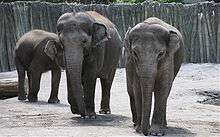 Asian elephants at the zoo | |
| Date opened | 1888 |
|---|---|
| Location | Washington Park, Portland, Oregon, United States |
| Coordinates | 45°30′30″N 122°42′53″W / 45.50833°N 122.71472°WCoordinates: 45°30′30″N 122°42′53″W / 45.50833°N 122.71472°W |
| Land area | 64 acres (26 ha)[1] |
| No. of animals | 1,955[1] |
| No. of species | 232[1] |
| Annual visitors | 1.6 million (2013)[1] |
| Memberships | AZA[2] |
| Major exhibits | The Great Northwest, Predators of the Serengeti, Africa Rainforest, Steller Cove, Elephant Lands |
| Website |
www |
The Oregon Zoo, formerly the Washington Park Zoo,[3][4] is a zoo in Portland, the largest city in the U.S. state of Oregon. Located 2 miles (3.2 km) southwest of Downtown Portland, the zoo is inside Portland's Washington Park, and includes the 2 ft 6 in (762 mm) narrow gauge Washington Park & Zoo Railway that connects to the International Rose Test Garden inside the park. Opened in 1888 after a private animal collector donated his animals to the City of Portland, the 64-acre (26 ha) zoo is now owned by the regional Metro government.
A member of the Association of Zoos and Aquariums, it has species survival plans for twenty-one endangered/threatened species, among which are successful breeding programs for endangered California condors, Asian elephants, and in recent times, African lions too. (The latter was under recommendation by the AZA).[5] The zoo also boasts an extensive plant collection throughout its animal exhibits and specialized gardens.[6] During the summer it is host to a concert series, and in the winter produces ZooLights, a holiday light show. The Oregon Zoo is Oregon's largest paid and arguably most popular attraction, with more than 1.6 million visitors in 2008 to 2009.[7]
History
The Oregon Zoo was founded in 1888,[3] making it the oldest North American zoo west of the Mississippi.[8] It all began with two bears purchased by Richard Knight, one brown bear and one grizzly.[9][10] A former seaman turned pharmacist, Knight began collecting animals from his seafaring friends. He kept his collection in the back of his drug store on Third & Morrison streets. When caring for the animals became too large a responsibility he sought to sell them to the city of Portland. Instead of buying the animals, the city offered to give Knight two circus cages and allowed him to place the caged bears on the grounds of City Park (now called Washington Park).[9]
Care and feeding of the bears, however, still fell to the Knight family and friends. It wasn't long before Knight addressed the city council again regarding the bears. Just five months later, he offered to donate the bears, along with their cages, to the city. Portland City Council accepted his offer[9] on November 7, 1888, and thus began the Portland Zoo.[3] Located in Washington Park, it was sometimes referred to as the Washington Park Zoo.[11][12]
By 1894, there were over 300 animals in the zoo’s collection. In 1925, the zoo moved to the site of the present Portland Japanese Garden, still within Washington Park.
The zoo moved again in 1958–59 to its current site, designed by Lawrence, Tucker & Wallmann.[13] This was located in Hoyt Park, west of Washington Park,[14] but some years later the two parks were combined as Washington Park. At this time, the Portland Zoo Railway was constructed to connect the zoo to its former site in Washington Park and other attractions there. The zoo's move to the new, much larger site was made in stages, over more than a year, with the first animals being moved in spring 1958 and limited public access being opened in June 1958, one day after the first section of the Zoo Railway opened.[15] During the transition period the new zoo was only open on weekends, as most animals were still at the old site awaiting completion of their new enclosures.[16] However, the new railway operated six days a week until mid-September. Meanwhile, the old zoo remained in operation, but in May 1959 was restricted to pedestrian access only, closed to automobile access, for its last months of operation.[17]
The zoo at its current site opened on July 3, 1959.[18] It was renamed the Portland Zoological Gardens at that time,[3] but remained commonly known as the Portland Zoo. The elephants and big cats were not moved to the new zoo until November.[19][20] A new interchange was constructed on the adjacent freeway, the Sunset Highway, for better access to the new zoo.[21]
The zoo became popular locally in 1953, when Rosy the Asian elephant was acquired. The zoo became world-famous in 1962 when the Asian elephant "Packy" was born. He was the first elephant born in the Western Hemisphere in 44 years and was (as of 2010) the tallest Asian elephant in the United States at 10.5 ft (3.2 m) tall. A total of 28 more calves have been born at the Oregon Zoo, including seven sired by Packy (two of which, Shine and Rama, lived with him until his death in 2015), making it the most successful zoo elephant breeding program in the world. On August 23, 2008, Rose-Tu, the granddaughter of the zoo's first elephant Rosy, gave birth to a son named Samudra. The birth made Samudra the first third-generation captive-born elephant in North America.[22]
Until 1971, the zoo was operated by the City, and then by the Portland Zoological Society under contract to the City.[3][23][24] In 1976, area voters approved a tax levy plan under which the zoo was taken over by the Metropolitan Service District (or MSD, now known as Metro).[25] Ownership of the zoo passed to Metro on July 1, 1976. Metro has continued expansion projects, aided by donors, sponsors and volunteers.[3]
Later in 1976, MSD renamed the zoo the Washington Park Zoo[3] after a naming contest.[12] The railway was renamed the Washington Park and Zoo Railway two years later.

The Metro Council changed the zoo's name from the Washington Park Zoo to the Oregon Zoo in April 1998.[4] In September of that year, the zoo became accessible by the region's MAX light rail system, with the opening of a Westside MAX line featuring an underground Washington Park station.[26] In 2003, the zoo began participation in a California condor recovery program started by San Diego Wild Animal Park and Los Angeles Zoo. The program is designed to breed California condors to be released into the wild and save them from extinction.[27]
In November 2008, regional voters approved a $125 million bond measure to improve infrastructure, enhance older exhibits and increase access to conservation education and the degree of sustainability.[28] Attendance at the zoo reached a record 1.6 million visitors for their 2008 to 2009 year.[7] The record was due in part to the birth of another baby elephant.[7] A new record was set the following year with 1,612,359 people visiting the zoo.[29]
On February 9, 2017, Oregon Zoo staff decided to euthanize Packy after a long struggle with drug-resistant tuberculosis. He was laid to rest at an unidentified city-owned "wooded, grassy area" that is not open to the public.[30] At the time of his death, Packy was 54 years old, the oldest living Asian elephant in North America.
Exhibits
Africa Rainforest
Opened in 1991, the Africa Rainforest exhibit covers 1.3 acres (5,300 m2) and was built at a cost of $4.3 million.[31] In addition to animals, the exhibit includes artwork and the Kongo Ranger Station, a mock up of a safari expedition.[31] Animals in the exhibit include Rodriguez fruit bats, straw-colored fruit bats, Egyptian fruit bats, colobus monkeys, Allen's swamp monkey, hadada ibis, white-faced whistling ducks, slender-snouted crocodile, Nile monitor lizard, lungfish, cichlids, lesser flamingos, geckos, chameleons, African crested porcupines, African clawed frogs, and hooded vultures. The rainforest includes four main areas: the Bamba Du Jon Swamp, which houses the lungfish, cichlids, frogs and reptiles; the rainforest aviary, which houses the birds; the monkey habitat which houses the monkeys and chameleon; and the bat habitat.[31]
Africa Savanna
The Africa Savanna exhibit opened in April 1989 and is 4 acres (16,000 m2) in size.[32] This exhibit includes animals typical of East Africa and includes an aviary and areas for large mammals.[32] These include black rhinoceros, De Brazza's monkey, hippopotamus, bontebok, naked mole-rat, reticulated giraffe, masai giraffe, gerenuk, Speke's gazelle, southern ground hornbill, weaver birds, Cape thick-knee, red-crested turaco, hamerkop, buffalo weaver, hingeback tortoises, and spiny-tailed lizards.[32] The zoo kept a zebra named Citation until her death in 2013.
Predators of the Serengeti
Predators of the Serengeti, which opened in September 2009, covers 2.5-acre (10,000 m2) and cost $6.8 million to build.[5][33] It is located on the site of the former Alaska Tundra exhibit, with some of the animals from the Alaska exhibit moved to other locations inside the zoo, such as the wolf exhibit. Animals in the Serengeti exhibit include lions, cheetahs, African wild dogs, caracals, scorpions, dwarf mongoose, and African rock python.[33] The zoo previously had lions, but closed the exhibit in 1998 and converted the area into Steller Cove.[5] The three new lions come from zoos in California, Virginia and Wisconsin.[5] On September 4, 2013, it was announced that five-year-old Neka, one of the zoo's two female lions, was pregnant and would likely soon give birth, it then happened in late 2013, as she gave birth to three cubs, named Kamali, Zalika and Angalia respectively. In August 2014, it was announced that the other lioness, Kya, was due herself. On September 8, 2014, Kya gave birth to a litter of four lion cubs. Three days later, however, one of the cubs had to be humanely euthanized due to an untreatable leg injury.[34]
Amazon Flooded Forest
This exhibit opened in September 2001. It simulates the Amazonian basin during its seasonal floods. Visitors can view the flooded environment from either above or below the water. Animals in the exhibit include black howler monkey, white-faced saki monkey, Arrau turtle, dwarf caiman, emerald tree boa, cardinal tetra, Heckel discus, orange spot, pacu, arowana, green anacondas, red piranhas, caiman lizards, basilisk lizards, and indigenous frogs.[35]
Elephant Lands
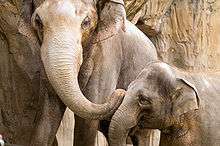
Four female (Sung-Surin "Shine", Rose-Tu, Chendra, and Lily) and one male (Samudra "Sam") Asian elephants are displayed at the popular elephant exhibit. All were born at the zoo, except Chendra, who was orphaned in the wild. Chendra is the only Borneo elephant in the United States. On November 30, 2012, at 2:17 a.m., Rose-Tu and the late Tusko (who are also the parents of Samudra) had a female calf Lily, weighing about 300 lbs(136 kg) at birth. There is a swimming hole in which up to ten elephants can simultaneously completely submerge, sandy ground for comfortable walking and a scratching station, which the elephants often choose to scratch their head, sides, belly, etc. The exhibit was recently enlarged from 1.5 acres (6,100 m2) to 6 acres (24,000 m2), expanding into the same location as the elk and wolves (now gone) once were. Construction for the expansion began in 2013, and included a variety of terrain (meadows, forests, and mud wallows with sand lining the whole enclosure), a timed-feeding system to provide more natural stimulation, and an eco-friendly heating system to keep them warm year-round. Areas of the exhibit such as the Encounter Habitat were completed in summer of 2014, and their new habitat was finished in autumn of 2015.[36]
Bears

There are six bears in three separate bear exhibits. One polar bears (Ursus maritimus), Nora, is located in an exhibit that is designed to mimic the area near Hudson Bay in Canada.[37] The exhibit previously had another female, Yugyan, but she was euthanized in August 2008 due to kidney failure. The exhibit opened in 1986 and has two pools of water for the animals, one for winter and one for summer.[37] There is one female Malaysian sun bear (Helarctos malayanus), named Jody, in a tropical forest environment simulated in part with heat producing artificial trees.[37] The Great Northwest exhibit's Black Bear Ridge has four black bears (three males and one female) added in April 2010 after the previous three had been euthanized for health reasons. Their names are Tuff, Dale, Cubby, and Takota.[38]
Great Northwest
This exhibit includes wildlife from the western portions of the Pacific Northwest, and has eight areas: Black Bear Ridge, Eagle Canyon, Cascade Stream and Pond, Cougar Crossing, Cascade Crest, Trillium Creek Family Farm, and Steller Cove.[39][40] Cascade Canyon Trail connects each of the exhibits, except Steller Cove, and includes a suspension bridge that offers views of Black Bear Ridge.[41]
Cascade Stream and Pond is the oldest of these exhibits, and opened in 1982 and features beavers, North American river otters, ring-tailed cats, egrets, and herons.[42] Opened in 1998, Cascade Crest is a mountain-like exhibit made mostly of basalt and features a snow cave, cirque lake, and twisted alpine trees. The 10,920 square feet (1,015 m2) exhibit cost $11.6 million and is located near the entrance to the zoo.[43] The only animals are mountain goats.[43] Black Bear Ridge is the next exhibit along the Cascade Canyon Trail.[41] The $2 million area opened in 2007 and is home to bobcats.[44] The exhibit had three American black bears, but all three were euthanized in 2009 due to various causes. The zoo acquired four new bears from a Utah zoo.
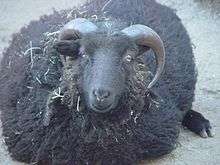
Eagle Canyon is the next exhibit along the trail and has two bald eagles along with coho salmon, sturgeon, rainbow and bull trout in a stream.[45] This 20,800-square-foot (1,930 m2) area opened in 2004.[45] Cougar Crossing comes after Eagle Canyon and features two cougars, Chinook and Paiute, in a 4,260-square-foot (396 m2) facility that opened in 2006.[46] The last area along the Cascade Canyon Trail is the Trillium Creek Family Farm. Opened in 2004 at a cost of $1 million, animals are presented by high school students who also explain local farming historical trends, technology, and demonstrate related activities such as composting, shearing, and agriculture.[47] A variety of domestic animals such as Guinea pigs, Pygora goats, Pygmy goats, Nankin chickens, runner ducks, and domestic rabbits are part of the farm's exhibits. The final area of the Great Northwest Exhibit is the Steller Cove which features animals and plants from the Oregon Coast.[48] The $11 million exhibit opened in 2000 and includes a tide pool and kelp forest populated with harbor seals, (Phoca vitulina), sea otters (Enhydra lutris), sea anemones, chiton, limpet, snail, mussel, crab, sea cucumber, urchin, sea star, rockfish, sculpin, goby, painted greenling, and gunnel.[48]
Condors of the Columbia
Three California condors, Kaweah, Tyrion and "432" (unnamed), moved into this new exhibit on May 24, 2014. These condors came from a large breeding facility located near Estacada, Oregon.
Other exhibits
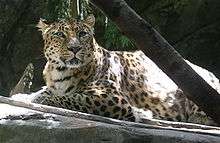
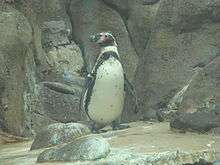
The zoo also has a Penguinarium which has Humboldt penguins, Inca terns, and Grey gulls near the Penguinarium is the Insect Zoo Hut (which is temporarily closed and is being moved into a new educational center). Other exhibits include the Cats of the Amur Region which houses Amur leopards and Amur tigers.[49] The Primate Exhibit features chimpanzees, orangutans, white-cheeked gibbons, mandrills, cotton-top tamarins and an occasional displayed reptile such as black tree monitors and green iguanas. Red Ape Reserve opened September 3, 2010 and in 2020, the chimpanzees and mandrills will have a new and better fit habitat to replace the old primate building (the Red Ape Reserve will stay). It is an indoor/outdoor exhibit housing both orangutans and white cheeked gibbons. There are two species of endangered wild pigs in the Asian Pigs exhibit: babirusas and Visayan warty pigs.
Controversies
The birth of Packy in 1962 began an elephant breeding program at the Oregon Zoo, resulting in a total of 28 calves being born to date, of which seven were sired by Packy. Of these, however, 15 died prematurely and the whereabouts of two calves are unknown.[50] Some elephants such as Stoney[51] Sabu and Prince were sold to the circus, a few elephants such as Hanako and Dino were loaned to other zoos, whereas Emma and Teak were sold to private buyers.
In April 2000, Rose-Tu, a female elephant born at the zoo, was severely abused by her handler, resulting in 176 lacerations including puncture wounds allegedly due to the handler attempting to shove a bullhook into her anus. It's been speculated that the trauma suffered by her as a result of this experience may have compromised her ability to raise calves.[52] The handler was let off with a minimal sentence, the best that the state laws could do at the time. As a fall out from this incident, Animal Legal Defense Fund authored the Rose-Tu law, signed by Governor Kitzhaber in 2001.[53] The law made Oregon the first state in the country to legally recognize the link between animal abuse and violence toward people, and increased the penalties for animal abuse.[54]
In December 2012, the baby elephant Lily was born to parents Rose-Tu and Tusko, a bull elephant on loan from Have Trunk Will Travel, a company that rents elephants. The Seattle Times brought to light a contract between the zoo and the company according to which the newborn calf Lily was owned by the company.[55] Initially the zoo denied knowledge about the contract, but after widespread public backlash, the zoo raised funds to buy both Tusko and Lily for $400,000.[56]
In May 2014, the zoo dismissed then-director Kim Smith and lead veterinarian Mitch Finnegan over their lapses in established protocols around the death of Kutai, a 20-year-old orangutan, during a surgery. After staff complaints over the veterinarian's termination at Metro Council, he was rehired in July.[57] In June 2014, during the period of his absence, six tamarin monkeys died at the zoo. They were a family of nine rare primates to arrive from Harvard University. Pathology reports indicated the deaths as due to systemic shock.[58]
The zoo has also faced criticism over its use of bullhooks or guides to control elephant behavior,[59] as well as for the prevalence of some health concerns such as arthritis, hoof rot, tuberculosis, and typical behaviors arising from captivity.[60]
The animal welfare organization In Defense of Animals has rated Oregon Zoo on their Ten Worst Zoos for Elephants list for five years.[61] The animal rights group "Free the Oregon Zoo Elephants" has been campaigning to end the zoo's captive breeding program and release the elephants (particularly Packy) to a sanctuary.
Other attractions
- Wildlife Live! summer shows, weather permitting
- Zoolights: December holiday evenings light display
- Washington Park and Zoo Railway
Nearby attractions
The zoo is located at the southern boundary of Washington Park, which is also the home of Portland Children's Museum, World Forestry Center, Oregon Vietnam Veterans Memorial, and Hoyt Arboretum. An adjacent trail system connects the zoo to the International Rose Test Garden, the Portland Japanese Garden, and Forest Park.
References
- 1 2 3 4 "About the Oregon Zoo". Oregon Zoo. Retrieved December 25, 2015.
- ↑ "List of Accredited Zoos and Aquariums". aza.org. AZA. Retrieved 13 August 2011.
- 1 2 3 4 5 6 7 "History [of Oregon Zoo]". Oregon Zoo. Retrieved April 11, 2012.
- 1 2 "Portland's zoo is now named Oregon Zoo". The Oregonian. April 25, 1998.
- 1 2 3 4 Meunier, Andre (September 10, 2009). "The zoo's $6.8 million exhibit, which houses three lions, keeps the roar alive". The Oregonian. Retrieved 2009-09-23.
- ↑ "Oregon Zoo Gardens". Oregon Zoo.
- 1 2 3 LaMarche, Bill (July 1, 2009). "Oregon Zoo's Baby Elephant Helps Smash Attendance Records". Zoo and Aquarium Visitor. Retrieved 2009-09-24.
- ↑ "The birth of the bond". Oregon Zoo. Retrieved April 11, 2012.
- 1 2 3 Goodall, Mary (March 16, 1958). "‘Patron Saint’ of Portland's Zoo Collected Animals, Birds at Drug Store Near Waterfront". The Sunday Oregonian, p. 41.
- ↑ "More Attractions for the Menagerie: Two Bears to be Added to the Free Show on Morrison Street". The Morning Oregonian, May 17, 1888, p. 8.
- ↑ "Dock Boss Finds Office Occupied by Young Deer: Washington Park Zoo in Line for Another Pet, but Loses Out by Very Narrowest of Margins". The Morning Oregonian, June 28, 1928, p. 16.
- 1 2 "Zoo contest prize taken by old name." The Oregonian, October 2, 1976, p. 1.
- ↑ Snyder, Eugene E. (1991). Portland Potpourri. Portland, Oregon: Binford & Mort. pp. 73–79. ISBN 0-8323-0493-X.
- ↑ Holm, Don (April 12, 1964). "Pittock Estate Needed to Complete Wondrous Park System". The Oregonian, pp. 40–41.
- ↑ "Many See Zoo, Train". The Oregonian, June 9, 1958, p. 15.
- ↑ "Russian Bears Inspect New Home at Zoo". The Oregonian, August 8, 1958, p. 26.
- ↑ "Zoo Opening Pushed Back 2 to 4 Weeks". The Oregonian, May 27, 1959, p. 1.
- ↑ Richards, Leverett G. (July 4, 1959). "Joy Reigns Supreme at West Hills Zoo As Wonders of New Park Are Unveiled". The Oregonian, p. 1.
- ↑ "Balky Elephants Moved By Force to New Home". The Oregonian, November 4, 1959, p. 14.
- ↑ "Move to New Zoo Set for Big Cats". The Oregonian, November 10, 1959, p. 19.
- ↑ "Road to Open to New Zoo". The Oregonian, October 10, 1959, p. 5.
- ↑ "Free the elephants! Problems plague the Oregon Zoo's pachyderms". Willamette Week.
- ↑ Sullivan, Ann (July 2, 1971). "Zoo's new director stresses education". The Oregonian, p. 26.
- ↑ "Change at zoo". The Oregonian, October 21, 1978, p. A22. Editorial.
- ↑ "Zoo plans expansion following levy approval". The Oregonian, May 27, 1976, p. C3.
- ↑ "Go west, young MAX" (September 9, 1998). The Oregonian (special section).
- ↑ "Condor egg could herald return of giant". CNN. 2007-04-03. Archived from the original on April 8, 2007.
- ↑ Siemers, Erik (November 14, 2008). "PCC, Zoo expect to face more robust bond market". Portland Business Journal. Retrieved 2009-09-24.
- ↑ Mortenson, Eric (January 7, 2010). "Despite economy, Oregon Zoo sets attendance record with more than 1.6 million visitors". The Oregonian. Retrieved 12 January 2010.
- ↑ Acker, Lizzie (February 9, 2017). "Oregon Zoo employees, visitors mourn death of Packy, Portland's 54-year-old elephant". The Oregonian. Retrieved 9 February 2017.
- 1 2 3 "Africa Rain Forest Exhibit". Exhibits. Oregon Zoo. Retrieved 2009-09-23.
- 1 2 3 "Africa Savanna Exhibit". Exhibits. Oregon Zoo. Retrieved 2009-09-23.
- 1 2 "Predators of the Serengeti". Exhibits. Oregon Zoo. Retrieved 2009-09-23.
- ↑ "Zoo News". Exhibits. Oregon Zoo. Retrieved 2013-09-04.
- ↑ "Amazon Flooded Forest". oregonzoo.org. Oregon Zoo.
- ↑ "Oregon Zoo Elephant Exhibit". oregonzoo.org. Oregon Zoo. Retrieved 2008-09-13.
- 1 2 3 "Bear Exhibit". oregonzoo.org. Oregon Zoo. Retrieved 2009-09-24.
- ↑ Muldoon, Katy (April 29, 2010). "Three black bears find a home at the Oregon Zoo". oregonlive.com. The Oregonian. Retrieved 29 April 2010.
- ↑ "The Great Northwest Exhibit". oregonzoo.org. Oregon Zoo. Archived from the original on July 23, 2011. Retrieved 2012-08-02.
- ↑ "Great Northwest". oregonzoo.org. Oregon Zoo. Retrieved 2012-08-02.
- 1 2 "Cascade Canyon Trail Exhibit". oregonzoo.org. Oregon Zoo. Archived from the original on July 23, 2011. Retrieved 2012-08-02.
- ↑ "Cascade Stream and Pond". oregonzoo.org. Oregon Zoo. Archived from the original on July 23, 2011. Retrieved 2012-08-02.
- 1 2 "Cascade Crest Exhibit". oregonzoo.org. Oregon Zoo. Archived from the original on July 23, 2011. Retrieved 2012-08-02.
- ↑ "Black Bear Ridge Exhibit". oregonzoo.org. Oregon Zoo. Archived from the original on July 18, 2011. Retrieved 2012-08-02.
- 1 2 "Eagle Canyon Exhibit". oregonzoo.org. Oregon Zoo. Archived from the original on July 18, 2011. Retrieved 2012-08-02.
- ↑ "Cougar Crossing Exhibit". oregonzoo.org. Oregon Zoo. Archived from the original on July 18, 2011. Retrieved 2012-08-02.
- ↑ "Trillium Creek Family Farm". oregonzoo.org. Oregon Zoo. Archived from the original on July 18, 2011. Retrieved 2012-08-02.
- 1 2 "Steller Cove Exhibit". oregonzoo.org. Oregon Zoo. Archived from the original on July 18, 2011. Retrieved 2012-08-02.
- ↑ "Cats of the Amur Region". oregonzoo.org. Oregon Zoo. Retrieved 2009-09-24.
- ↑ "Oregon Captive Breeding Record". helpelephants.com. Retrieved 2014-04-22.
- ↑ "Surplus Animals: The Cycle of Hell" (PDF). PAWS. Retrieved 2014-04-22.
- ↑ "The lesson of Rose-Tu and her calf". Oregonian. Retrieved 2014-10-19.
- ↑ "Honoring Animal Victims: Landmarks in Legislation". ALDF. Retrieved 2014-10-19.
- ↑ "ORS 167.320". OregonLaws.org. Retrieved 2014-12-23.
- ↑ "Portland's baby elephant belongs to traveling show". Seattle Times. Retrieved 2014-04-22.
- ↑ "Oregon Zoo pays $400,000 for elephants Lily and Tusko". Oregonian. Retrieved 2014-04-22.
- ↑ "Oregon Zoo brings back veterinarian fired over death of orangutan". Oregonian. Retrieved 2014-10-19.
- ↑ "Six Oregon Zoo monkeys that mysteriously died simultaneously showed signs of shock, stress". Oregonian. Retrieved 2014-10-19.
- ↑ "Oregon Zoo fact sheet". helpelephants.com. Retrieved 2014-04-22.
- ↑ "NWExaminer" (PDF). Retrieved 2014-04-22.
- ↑ "Ten Worst Zoos for Elephants". idausa.org. Retrieved 2014-04-22.
External links
| Wikimedia Commons has media related to Oregon Zoo. |